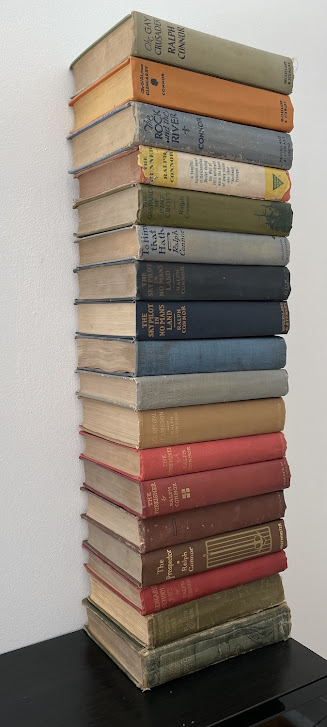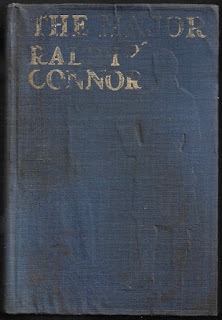06 June 2022
Accidents Never Happen in a Perfect World
03 June 2022
Reading Writing About Richard Rohmer
Lieutenant-General Richard Rohmer's commanding countenance graces the cover of the new issue of Zoomer, just now hitting the stands. A cover boy at 98, his appearance owes something to Her Majesty's Platinum Jubilee. In the corresponding article, "A General Fit for a Queen," Ian Coutts writes of Rohmer's decades-long relationship with our monarch, his life, his various careers, and his bestselling thrillers.
I'm honoured to have been interviewed for the piece. An elementary school discovery, Richard Rohmer was my very first favourite Canadian author. Eight years ago, with pals Chris Kelly and Stanley Whyte, I resolved to read every single one of his books. We very nearly succeeded. The blog Reading Richard Rohmer documents our adventure.
Richard Rohmer hasn't published a new book since 2007's Ultimatum 2. And so, I was excited to read this in Ian's article: "As we wind down the interview, Rohmer hands me the dazzling, fiery abstract cover design for the non-fiction book he is working on, about high air temperatures in the Rockies and melting permafrost."
How's that for a teaser?
Long live the queen!
Long live the general!
01 June 2022
The Dustiest Bookcase: W is for Wiseman
Adele Wiseman
Toronto: Prototype, 1978
58 pages
Adele Wiseman died thirty years ago today.
Still unread – by me, anyway – this copy of Testimonial Dinner was brought out of storage by a savvy bookseller the next day.
$15.00
Signed.
I was an easy mark.
A play, Testimonial Dinner has the very look of a self-published book. Perhaps it was. In The Force of Vocation: The Literary Career of Adele Wiseman (Winnipeg: University of Manitoba, 2006), Ruth Panofsky, writes that it was "printed privately for the author."
I may not have read Testimonial Dinner, but I have read and reread the back cover. In my twenties, it seemed unbelievable. Thirty years later, Wiseman's experience doesn't surprise me in the least.
30 May 2022
Walking in on Virginia Box and Baird Rodd
James Moffatt
London: New English Library, 1974
112 pages
I first visited the UK in 1974, arriving on a British Airways jet still painted in BOAC colours. My mother had brought us – my sister and myself – to meet relatives and friends of our late father. She gave me fifteen pounds, by far the most money I'd ever held held, which I spent it on a hardcover copy of the most recent Guinness Book of Records, a SHADO Interceptor, and a SHADO 2 Mobile.
The SHADO Dinkys have proven good investments – I have them still – but if I could go back in time, I would buy every copy of Skinhead, Suedehead, Demo, Boot Boys, Skinhead Escapes, Skinhead Girls, Glam, Smoothies, Sorts, Teeny Bopper Idol, Top Gear Skin, Trouble for Skinhead, and Skinhead Farewell I could find. Written by Canadian James Moffatt, sold for 30p, few can be purchased for under one hundred quid today.
The Girl from H.A.R.D.: Virginia Box and the "Unsatisfied" was published during that 1974 summer in England. The second novel in the series, Moffatt presumes that the reader has read the first (right). I had not, but found it took little time to get up to speed. H.A.R.D. is the Hemisphere Administration for Regional Defence. Virginia Box – "leggy, busty blonde" – is its most valued agent. Baird Rodd is her superior. He sits on a "phallic-backed chair" behind a buttock-shaped "erotic desk."
It stank of Rodd manipulation. As if her boss had deliberately put the computers to work and punched Box against lesbian and waited for a tray of cards to provide him with some inner, perverted sense of achievement.
Quickly now, she dressed. When she finished she postured before the mirrors again. The small, uplift brassiere did nothing except emphasise how firm her breasts really were and hoe exciting their nipples could be when fully awakened. The transparent blouse let every man see this. And the mini-skirt only served too whet appetites which could not, after one glance, have failed to be already whetted. Curvaceous legs, more curvaceous thighs beckoned sensually."You're a sight for sore, lecherous eyes," she told her glassy self.
Object and Access: A slim softcover. If WorldCat is to believed – why should it? – only the National Library of Scotland has a copy. Mine was bought four years ago. I see only one copy listed for sale online. At US$9.96 it might seem a bargain, but the bookseller lists the shipping from New Zealand to Canada at an even US$37.00.
13 May 2022
$2 Connors
I will pay no more than two dollars on a book by Ralph Connor. This policy has stood me well. To date, my Connor collection consists of eighteen volumes – nearly all first editions – purchased at a total cost of thirty dollars and fifty cents.
This 1901 Westminster copy of The Man from Glengarry is the oldest. One bookseller believed it to be a first edition, and hoped that it would bring twenty dollars. Perhaps it did. I rescued it from a pile of books considered too damaged to be sold in a Friends of St Marys Public Library book sale.
The very first Connor I ever bought is this Triangle edition of The Runner, his 1929 novel of the War of 1812. The only one to have a dust jacket, I was won over by the publisher's description.
I found this 1917 McClelland, Goodchild & Stewart edition of The Major at an outdoor bookstall in London, Ontario. It's in pretty rough shape, but at one dollar I couldn't resist. Besides, it was about to rain.
Imagine my surprise in discovering this inscription after returning home:
I bought this copy of The Prospector for two dollars from a bookseller who knew it was signed. He'd given up on his dreams of making $9.95... or even $5.00.
You too can own a signed Connor! They can be purchased online for as little as US$12.00.
Too dear for me.
I began this piece forgetting that I'd mentioned my $2 Connor policy in a 2016 review of The Man from Glengarry. At the time, my collection consisted of sixteen titles. In the six years that have followed that number has grown by only two.
Has inflation taken its toll? Is two dollars now too low? Should be I raising my cut-off to three dollars? Four?
What think you?





















